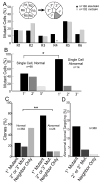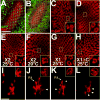The cadherin Flamingo mediates level-dependent interactions that guide photoreceptor target choice in Drosophila
- PMID: 18400160
- PMCID: PMC2494600
- DOI: 10.1016/j.neuron.2008.01.007
The cadherin Flamingo mediates level-dependent interactions that guide photoreceptor target choice in Drosophila
Abstract
Quantitative differences in cadherin activity have been proposed to play important roles in patterning connections between pre- and postsynaptic neurons. However, no examples of such a function have yet been described, and the mechanisms that would allow such differences to direct growth cones to specific synaptic targets are unknown. In the Drosophila visual system, photoreceptors are genetically programmed to make a complex, stereotypic set of synaptic connections. Here we show that the atypical cadherin Flamingo functions as a short-range, homophilic signal, passing between specific R cell growth cones to influence their choice of postsynaptic partners. We find that individual growth cones are sensitive to differences in Flamingo activity through opposing interactions between neighboring cells and require these interactions to be balanced in order to extend along the appropriate trajectory.
Figures




Comment in
-
Of cartridges and columns: new roles for cadherins in visual system development.Neuron. 2008 Apr 10;58(1):1-3. doi: 10.1016/j.neuron.2008.03.024. Neuron. 2008. PMID: 18400154
References
-
- Chae J, Kim MJ, Goo JH, Collier S, Gubb D, Charlton J, Adler PN, Park WJ. The Drosophila tissue polarity gene starry night encodes a member of the protocadherin family. Development. 1999;126:5421–5429. - PubMed
-
- Clandinin TR, Zipursky SL. Afferent growth cone interactions control synaptic specificity in the Drosophila visual system. Neuron. 2000;28:427–436. - PubMed
-
- Clandinin TR, Zipursky SL. Making connections in the fly visual system. Neuron. 2002;35:827–841. - PubMed
-
- Das G, Reynolds-Kenneally J, Mlodzik M. The atypical cadherin Flamingo links Frizzled and Notch signaling in planar polarity establishment in the Drosophila eye. Dev Cell. 2002;2:655–666. - PubMed
Publication types
MeSH terms
Substances
Grants and funding
LinkOut - more resources
Full Text Sources
Molecular Biology Databases

